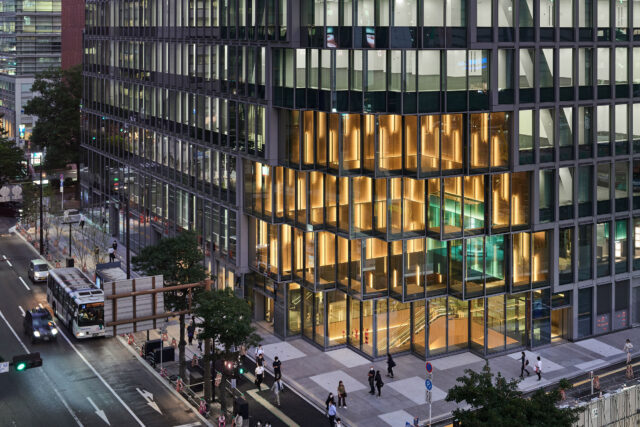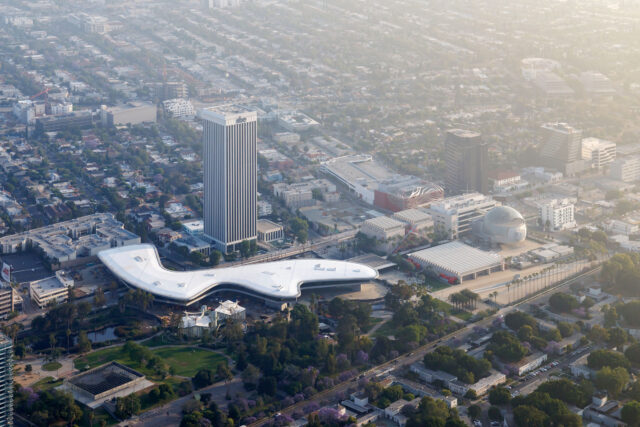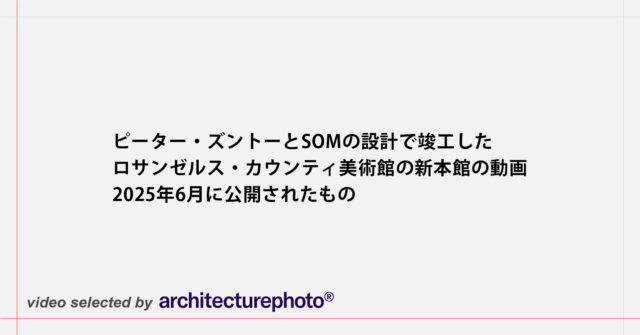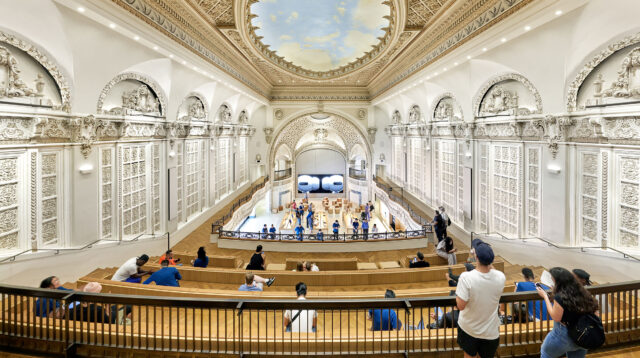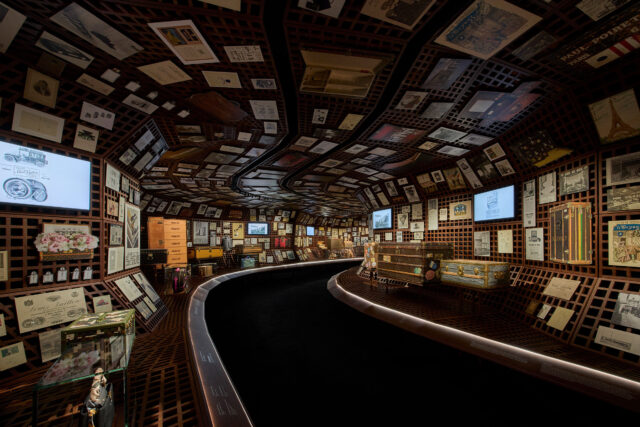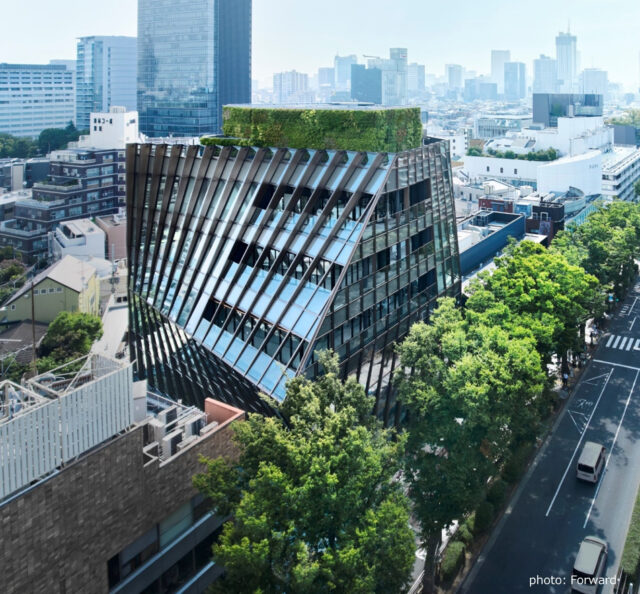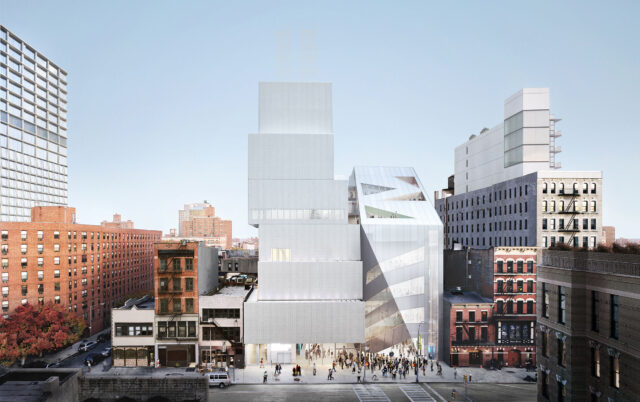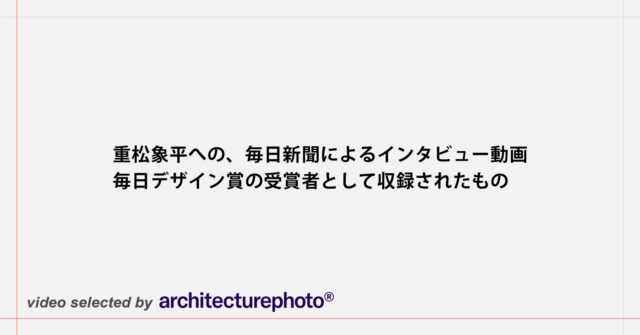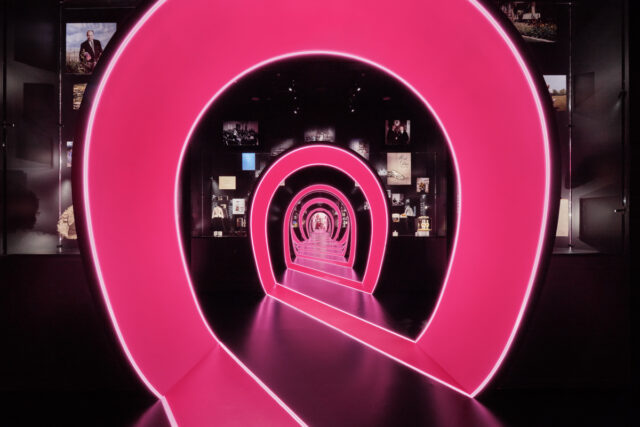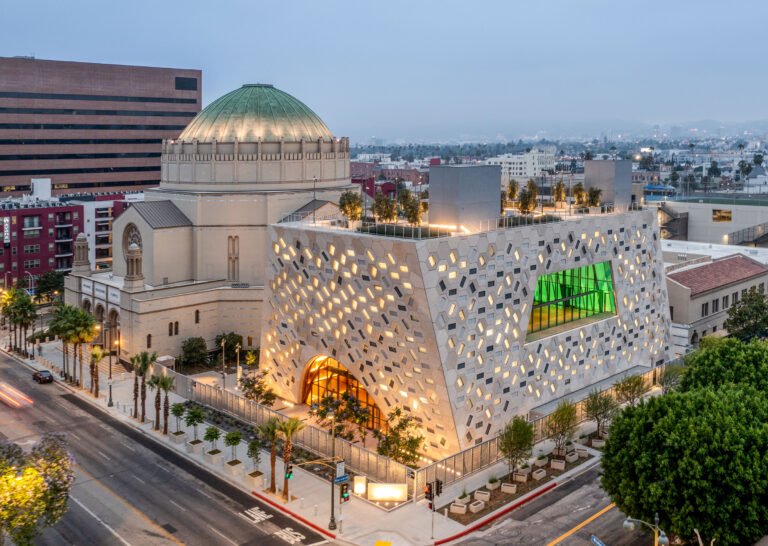
SHARE OMA / 重松象平による、ロサンゼルスの「オードリー・イルマス・パヴィリオン」。構内の歴史的な既存寺院への敬意を形態で表現しつつ、新たなコミュニティの場として都市に寄与する3つの集いの空間を持つ建築を計画





OMA / 重松象平が設計した、アメリカ・ロサンゼルスの「オードリー・イルマス・パヴィリオン」です。構内の歴史的な既存寺院への敬意を形態で表現しつつ、新たなコミュニティの場として都市に寄与する3つの集いの空間を持つ建築が計画されました。施設のオープンは2022年1月の予定とのこと。施設の名称となっているオードリー・イルマスは施設建設に大きな寄付をした人物の名前で、アートコレクターとしても知られています。
こちらはリリーステキストの翻訳です
OMA / 重松象平の設計によるウィルシャー・ブルバード寺院の「オードリー・イルマス・パヴィリオン(Audrey Irmas Pavilion)」が完成
2021年9月1日 – カリフォルニア州ロサンゼルス – OMAニューヨークが宗教団体から初めて依頼を受け、カリフォルニア州で初の文化的建築物となったオードリー・イルマス・パヴィリオンが重要な建設の節目を迎え、2022年1月にオープンする予定です。
オードリー・イルマス・パヴィリオンは、10年以上にわたるロサンゼルスでの建設努力の結果、OMAにとってロサンゼルスで初めての文化的建築物であり、宗教法人のための最初のプロジェクトとなりました。コリアタウン/ウィルシャーセンターの中心部、ウィルシャー大通りに位置する約5,100㎡のパヴィリオンは、ウィルシャー大通りにある寺院が必要としていた集いの場を作るという構内のヴィジョンに応えたものです。
オードリー・イルマス・パヴィリオンと名付けられたこのパヴィリオンは、2015年に3,000万ドルの寄付をしてキャピタルキャンペーンを開始した主な寄付者にちなんで名付けられたもので、米国の寺院への単独寄付としては最大規模のものです。オードリー・イルマスは、「生涯にわたる会衆の一員として、またオードリー・イルマス・パビリオンを支援する主な寄付者として、この建物が当初の構想よりもさらに素晴らしい形で完成するのを見ることができ、感激しています」と語りました。また、「この建物は、今後何年にもわたって広く地域の人々に親しまれる重要な集いの場となるでしょうし、私はその始まりの一端を担うことができてとても嬉しく思っています。」と語りました。
2015年に、コンペでOMAが選ばれ、建物の設計を担当しました。オードリー・イルマス・パヴィリオンは、既存の構内アクティビティとの新たなつながりを構築するとともに、都市空間を取り込み、新たな市民の拠り所となる集いのプラットフォームとなります。このパヴィリオンは、歴史的な伝統を尊重すると同時に、現代の市民のニーズを反映することで、人が集まることのエネルギーを利用することを目的としています。
OMAのパートナー・イン・プレジデントである重松象平は述べています。
「オードリー・イルマス・パヴィリオンの建設は、COVID-19パンデミックという、人と人との関わり方が問われた時代に、前進する勢いを維持するものでした。このパヴィリオンの完成は、私たちが再び集うことを望む時期であり、この建物は集い、交流し、共同体の精神の重要性を再認識するためのプラットフォームとなるでしょう。」
スティーブ・レダー(※ユダヤ人コミュニティのリーダー)は次のように述べています。
「オードリー・イルマス・パヴィリオンが完成したことで、歴史的な聖域の修復、最先端の幼児教育と小学校の建物とプログラム、スポーツ複合施設、貧しい人々のための食糧確保、歯科治療、眼科治療、韓国語、スペイン語、英語での法律扶助、メンタルヘルスサービス、駐車場、すべての人のための強固なセキュリティ、そして最後にオードリー・イルマス・パヴィリオンを建設する計画を含む 『Building Lives Campaign』が完了したことになり、私たちは感激しています。この現代的な傑作により、寺院は、私たちのコミュニティとロサンゼルス市全体に、新たに見事な輝きを放つランドマークをもたらしました。このパビリオンは、学び、集い、与えるための確固たる施設としての私たちの役割をさらに表現しています。長い年月をかけてこの計画が実現し、私たちの都市のキャンパスに最後の息を呑むような建物が加わるのを見るのは素晴らしいことです。」
パヴィリオンのアプローチは、シンプルかつコンテクストに沿ったものです。出発点は、イベントスペースとしてはあまりにも一般的な「箱」でした。この基本的な箱は、構内の隣接する歴史的建造物に敬意を表して形作られています。
西側の建物は、既存の寺院から離れるように傾斜しており、2つの建物の間に新たな中庭を設けることで、思いやりのある緩衝となっています。パヴィリオンは、歴史的な学校から離れて南に傾き、既存の中庭を空に向かって開き、光を取り入れています。平行四辺形の建物は、同時に都市の主要な回廊であるウィルシャー大通りに向かって伸びており、新しい都市の存在感を示しています。その結果、隣人との関係性によって刻まれたフォルムが生まれました。謎めいていると同時に親しみやすく、控えめでありながら前向きであり寺院の対極に位置しています。
イベントスペースは、柔軟性のために個性を犠牲にすることがよくあります。ここでは、スケールや空間の特性を多様化することで、柔軟性を提供しています。パヴィリオンは、メインのイベントスペース(大)、チャペルとテラス(中)、サンクンガーデン(小)の3つの異なる集いの空間で構成されており、建物を貫く空間として表現されています。この3つの空間は、それぞれの空間に出入りするための視点を設けるために、1つ1つの空間が重なり合っています。それぞれのスペースには、光を遮断する一連の開口部があり、神殿や歴史的な学校への眺めを縁取ることで、来訪者の方向性を変えています。
OMAのパートナーである重松象平は言います。
「私たちは、形、スケール、オーラが異なる空間の集団を組み立てました。木で覆われた押し出し成形のヴォールトは、多機能で中央の集会スペースとつながりのある突起を確立し、台形のヴォイドは、テンプルのドームからトーンを引き出し、アーチ型のステンドグラスの窓を縁取ります。3つのヴォイドが相互に連結していることで、パヴィリオンの強固なフォルムは戦略的でありながら驚くほど多孔質なものとなり、構内と都市を結びつけています。このパヴィリオンは、新旧両方の活動、価値観、伝統をサポートし、新たな集いのエネルギーを育みます。」
地上階のメインイベントスペースは、寺院のドームと同じように、弧を低くして敷地の北側に押し出し、ウィルシャー・ブルバード通りと学校の中庭をつなぐようになっています。柱のないアーチ型の空間は、宴会、マーケット、コンベンション、パフォーマンス、アートイベントなど、様々なプログラムを開催することができます。オクルス(※ドームの中央部に設けられた円形の天窓)からは歴史的建造物である寺院のドームが見えるようになっています。
2階には、より親しみやすいチャペルと屋外テラスがあります。台形の部屋とテラスは西向きで、歴史的建造物である神殿のアーチ型ステンドグラスの窓を囲んでいます。3つ目の空間は、3階の小さな会議室と屋上のイベントスペースをつなぐサンクンガーデンで、ロサンゼルスの街並みやハリウッドサイン、北側の山々を一望できます。これらのヴォイドが一体となって、説教や勉強、成人式やコンサート、仕事やリラクゼーションなど、さまざまな目的に応じた多様なスペースが形成されています。
OMAアソシエイトのジェイク・フォースターは言います。
「ウィルシャー大通りの寺院コミュニティの理想的なホストとして、オードリー・イルマス・パヴィリオンは、内部と外部の両方に関わることができる集会スペースを提供しています。古典的なパヴィリオンとの関係において、このパヴィリオンはダイナミックな対話を提供し、神殿から丁重に身を乗り出し、ウィルシャー・ブールバード通りに向かって傾いて訪問者を招き入れます。また、複数の階に渡って配置された内外の複合的な空間は、構内と都市を繋ぎ、既存の寺院を新たな視点で捉えています。」
「寺院との6年間の共同作業を経て、デザインチームは、精神的なもの、自治体的なもの、反射的なもの、共同体的なもの、柔軟でありながらユニークなものなど、多様なコミュニティのニーズに応えることができる軽快なインフラを提供できたことを誇りに思っています。」
ファサードは、寺院のドーム内部の幾何学的な形状を利用しています。長方形の窓が付いた六角形のユニットを回転させて内部のプログラムを反映させ、それを集約して独特のパターンを作り出しています。1,230枚のGFRCパネルは、建物のヴォリューム感を強調すると同時に、重厚さを打ち破る人間的なスケールの質感を加えています。このパネルの色調と素材感は、既存の神殿やキャンパスの質感と共鳴し、パヴィリオン内の色彩を際立たせています。一見ニュートラルなファサードの色は、そのテクスチャーによって強調され、時間帯や個々のパネルの稜線の向きによってトーンが変化します。
OMAのレム・コールハースは、パヴィリオン内の各ドアフレームにメズーザー(※門柱)をデザインするよう依頼されました。メズーザーの目的は、神の存在を常に思い起こさせることであり、ユダヤ人の家が優しさ、律法、寛大さ、平和の場所であることを示すものです。今回のデザインでは、メズーザーの上にある「シン」と呼ばれる文字をひとつひとつ丁寧に作成し、手作業でカットし、ヤスリをかけて磨き上げた後、発泡アルミニウムと着色した樹脂で作られたメズーザーに貼り付けました。
レム・コールハースは語ります。
「パビリオン内のドアのためのメズーザーをデザインすることには、興味と挑戦がありました。宗教上の明確な命令、法律、規則に答えなければならず、予想外の宗教的な物体であるため、私にとっては非常に魅力的であり、人生のある時点では非常に良い教訓となりました。」
こちらは、建築家によるステートメント
私たちは、10年以上前からロサンゼルスに建物を建てようとしてきました。ウィルシャー・ブルバード寺院のためのオードリー・イルマス・パヴィリオンは、この街での私たちの最初の文化的建築物となります。また、私たちにとって初めての宗教施設でもあります。宗教施設は、礼拝の内外で共同活動を行う場所として、市民生活において常に重要な役割を果たしてきました。
寺院は、人々が集うさまざまな方法を受け入れる空間を作ることをキャンパスのヴィジョンとしました。この新しいパヴィリオンは、歴史的な伝統に敬意を払いつつ、現代の市民のニーズを反映した集いのエネルギーをどのように利用できるのでしょうか。
パヴィリオンは、既存の構内アクティビティとの新たなつながりを構築し、新たな市民の拠り所となるように、都市空間を招き入れることで、人が集まるための機械となるようデザインされています。私たちは、新しい市民の存在として認識されるような象徴的な建物でありながら、既存の寺院の象徴性を補完するような繊細な建物にしたいと考えました。私たちのアプローチは、シンプルかつコンテクストに沿ったものです。その出発点となったのは、イベントスペースとしてはあまりにも一般的な「箱」でした。この基本的な箱は、キャンパス内の隣接する歴史的建造物への敬意を込めて形作られています。
西側の建物は、既存の寺院から離れるように傾斜しており、2つの建物の間に新たな中庭を設け、配慮された緩衝となっています。パヴィリオンは、歴史的な学校から離れて南に傾き、既存の中庭を空に向かって開き、光を取り入れています。平行四辺形は同時に、都市の主要な回廊であるウィルシャー大通りに向かって伸びており、新しい都市の存在感を確立しています。その結果、隣人との関係性によって刻まれたフォルムが生まれました。謎めいていると同時に親しみやすく、控えめでありながら前向きな寺院と対をなしています。
ファサードは、寺院のドーム内部の幾何学的な形状を利用しています。長方形の窓を持つ六角形のユニットは、内部のプログラムを反映させるために回転させ、独特のパターンを作るために集合させています。このパネルは、建物のボリューム感を強調すると同時に、重厚さを打ち破る人間的なスケールのテクスチャーを加えています。
イベントスペースは、柔軟性のために個性を犠牲にすることがよくあります。ここでは、スケールや空間の特性を多様化することで、柔軟性を提供しています。このパビリオンは、メインのイベントスペース(大)、チャペルとテラス(中)、サンクンガーデン(小)の3つの異なる集いの空間で構成されており、建物を貫く空間として表現されています。この3つの空間は、それぞれの空間に出入りするための視点を設けるために、1つ1つの空間が重なり合っています。それぞれのスペースには、光を遮断する一連の開口部があり、寺院や歴史的な学校への視界を遮ることで、来訪者が複合施設とその先への方向性を再確認できるようになっています。
地上階のメインイベントスペースでは、寺院のドームの弧を低くして敷地の北側に押し出し、ウィルシャー大通りと学校の中庭をつなぐことで、寺院のドームを再現しています。柱のないアーチ型の空間は、宴会、マーケット、コンベンション、パフォーマンス、アートイベントなど、様々なプログラムを開催することができます。オクルスからは、空洞の上にある歴史的な寺院のドームを見ることができます。
2階には、より親しみやすいチャペルと屋外テラスがあります。台形の部屋とテラスは西向きで、歴史的な寺院のアーチ型ステンドグラスの窓を囲んでいます。3つ目の空間は、3階の小さな会議室と屋上のイベントスペースをつなぐサンクンガーデンで、ロサンゼルスの街並みやハリウッドサイン、北側の山々を一望することができます。これらのヴォイドを組み合わせることで、説教や勉強、成人式やコンサート、仕事やリラクゼーションなど、さまざまな目的に応じた多様なスペースが生まれました。
2020年のCovid-19パンデミックの影響で、建物のオープンは遅れ、危機感から人が集まるという行為そのものが中断されています。パビリオンは、集まることの価値を再確認し、さらには変化する集まるという概念を支えることができるのでしょうか。
以下の写真はクリックで拡大します


















































こちらはリリーステキストです。
OMA / Shohei Shigematsu Designed Audrey Irmas Pavilion at Wilshire Boulevard Temple is Completed
September 1, 2021 – Los Angeles, CA – The Audrey Irmas Pavilion, OMA New York’s first commission from a religious institution and first cultural building in California, reaches significant construction milestone and is expected to open in January 2022.
After more than a decade of efforts made to build in Los Angeles, the Audrey Irmas Pavilion (Pavilion) marks OMA’s first cultural building in the city and first project for a religious institution. Located on Wilshire Boulevard, in the heart of Koreatown/Wilshire Center, the new 55,000 square foot Pavilion is a response to the Wilshire Boulevard Temple’s vision for its campus to create a much-needed space to convene.
Named the Audrey Irmas Pavilion for its lead donor, whose $30 million gift launched the capital campaign in 2015, the gift was among the largest single donations to a Temple in the United States. “As a life-long member of the congregation and the lead donor supporting the Audrey Irmas Pavilion, I am elated to see the building come to completion even more spectacularly than it was originally envisioned,” said Audrey Irmas. She continued, “This building will be an important gathering space enjoyed by the wider community for years to come, and I am overjoyed to be a part of its beginnings.”
In 2015, OMA was selected from a competitive field to design the building. The Audrey Irmas Pavilion will be a platform for gathering, forging new connections with the existing campus activities while inviting the urban realm in to create a new civic anchor. The Pavilion aims to harness the energy of gathering by simultaneously respecting historic traditions and reflecting modern civic needs.
“The making of the Audrey Irmas Pavilion sustained forward momentum through the COVID-19 Pandemic, a period in which the act of human interaction was questioned and contemplated. Its completion comes at a time where we hope to come together again, and this building can be a platform to reinstate the importance of gathering, exchange, and communal spirit,” says Shohei Shigematsu, OMA Partner-in-Charge.
Rabbi Steve Leder states, “We are thrilled to see the completion of the Audrey Irmas Pavilion and with that, the completion of the Building Lives Campaign that included the plan to restore of our historic sanctuary, create state-of-the-art early childhood and elementary school buildings and programs, a sports complex, a social services center to help our needy neighbors with food security, dental and vision care, legal aid and mental health services in Korean, Spanish and English at no cost to them, parking, robust security for all, and finally the Audrey Irmas Pavilion. With this modern masterpiece, the Temple brings another stunning, radiant landmark to our community and the entire city of Los Angeles. The Pavilion further expresses our role as a steadfast institution of learning, gathering, and giving. It is amazing to see this come to fruition after so many years and to add the final, breathtaking building to our urban campus.”
The approach for the Pavilion is simple yet contextual. The starting point was a box: the all-too generic model for an event space. The basic box is shaped with forms out of respect to the adjacent historical buildings on the campus.
On the west side, the building slopes away from the existing Temple, creating a thoughtful buffer and framing a new courtyard between the two buildings. The Pavilion leans south, away from the historic school, opening an existing courtyard to the sky to bring light in. The parallelogram simultaneously reaches out toward the main urban corridor, Wilshire Boulevard, to establish a new urban presence. The resulting form is carved by its relationship to its neighbors. It is both enigmatic and familiar, creating a counterpoint to the Temple that is at once deferential and forward-looking.
Event spaces often sacrifice character for flexibility. Here, flexibility is provided through diversity in scale and spatial characters for gathering. The Pavilion consists of three distinct gathering spaces expressed as voids punctured through the building—a main event space (large), a chapel and terrace (medium), and a sunken garden (small). The three spaces are interlocked and stacked one atop another to establish vantage points in and out of each space. Within each space are a series of openings that filter light and frame views to the Temple and historic school, reorienting visitors to the complex and beyond.
Shohei Shigematsu, OMA Partner, says “We assembled a constellation of spaces, distinct in form, scale, and aura—an extruded vault enveloped in wood establishes a multi-functional, central gathering space and connective spine; a trapezoidal void draws tones from the Temple dome and frames its arched, stained-glass windows; and a circular sunken garden provides an oasis and passage to a roof terrace overlooking LA. Three interconnected voids make the solid form of the Pavilion strategically yet surprisingly porous, engaging the campus and the city. The Pavilion will support both old and new activities, values, and traditions to foster a renewed energy for gathering.”
At the ground level, the main event space echoes the Temple dome by lowering the arc and extruding it north across the site to connect Wilshire Boulevard to the school courtyard. In its full length, the vaulted, column-free expanse has the capacity to host diverse programs such as banquets, markets, conventions, performances, and art events. An oculus provides a view through the void above to the dome of the historic Temple.
On the second level is a more intimate chapel and outdoor terrace. The trapezoidal room and terrace face west, framing the arched stained-glass windows of the historic Temple. A third void is a sunken garden that connects smaller meeting rooms on the third floor to the rooftop event space with expansive views of Los Angeles, the Hollywood sign, and the mountains to the north. Together, the voids establish a diverse collection of spaces for multiple purposes—from sermons and studies, to b’nai and b’not mitzvah and concerts, to work and relaxation.
Jake Forster, OMA Associate, says “As the ideal host for the Wilshire Boulevard Temple community, the Audrey Irmas Pavilion provides gathering spaces that can engage both internally and externally. In relationship to its classical counterpart, the pavilion offers a dynamic dialogue, politely reclining from the Temple and leaning towards Wilshire Blvd to invite visitors in. A complex of interior and exterior spaces distributed over multiple levels connect campus to city and frame new perspectives of the existing temple.
After six years of collaborating with the Temple, the design team is so proud to deliver a nimble infrastructure ready to meet the diverse community’s needs – spiritual and municipal, reflective and communal, flexible but unique.”
The façade draws from the geometries of the Temple’s dome interior. A single hexagon unit with a rectangular window is rotated to reflect the program within and aggregated to create a distinct pattern. The 1,230 GFRC panels enhance the building’s volumetric character while adding a human-scaled texture that breaks down its mass. The tonality and materiality resonate with the textures of the existing Temple and campus while enhancing interior moments of color throughout the Pavilion. The seemingly neutral color of the façade is enhanced by its texture, changing in tone depending on the time of day and the orientation of individual panels’ ridges.
Rem Koolhaas of OMA was also commissioned to design a mezuzah for each door frame within the Pavilion. The purpose of the mezuzah is to act as a constant reminder of God’s presence, identifying Jewish homes as places of kindness, The Torah, generosity and peace. For their design, each individual letter atop each mezuzah called a shin, was meticulously developed, hand-cut, filed and polished before being adhered to the mezuzah crafted from aluminum foam and cast in colored resin. “I was both intrigued and challenged to design the mezuzahs for the doors within the Pavilion. It is an unexpected religious object having to answer explicit religious edicts, laws and rules which made it totally fascinating for me and a very good lesson to have at some point in my life.” says Rem Koolhaas.
こちらは建築家によるステートメントです。
We have been trying to build in Los Angeles for more than a decade and the Audrey Irmas Pavilion for the Wilshire Boulevard Temple marks our first cultural building in the city. It is also our first religious institution. Religious institutions have always played a critical role in civic life as places for communal activities in and out of worship.
The temple’s vision for its campus was to create a space to host the multiple ways in which people convene. How can the new pavilion harness the energy of gathering that is simultaneously respectful to historic traditions and reflective of modern civic needs?
The pavilion is designed to be a machine for gathering, forging new connections with the existing campus activities and inviting the urban realm in to create a new civic anchor. We wanted the building to be iconic enough to be recognized as a new civic entity but subtle enough to complement the iconicism of the existing temple. Our approach is simple yet contextual. The starting point was a box: the all-too-generic model for an event space. The basic box is shaped with forms out of respect to the adjacent historical buildings on the campus.
On the west side, the building slopes away from the existing temple, creating a thoughtful buffer and framing a new courtyard between the two buildings. The pavilion leans south, away from the historic school, opening an existing courtyard to the sky and bringing light in. The parallelogram simultaneously reaches out toward the main urban corridor, Wilshire Boulevard, to establish a new urban presence. The resulting form is carved by its relationship to its neighbors. It is both enigmatic and familiar, creating a counterpoint to the temple that is at once deferential and forward-looking.
The facade draws from the geometries of the temple’s dome interior. A single hexagon unit with a rectangular window is rotated to reflect the program within and aggregated to create a distinct pattern. The panels enhance the building’s volumetric character while adding a human-scaled texture that breaks down its mass.
Event spaces often sacrifice character for flexibility. Here, flexibility is provided through diversity in scale and spatial characters for gathering. The pavilion consists of three distinct gathering spaces expressed as voids punctured through the building—a main event space (large), a chapel and terrace (medium), and a sunken garden (small). The three spaces are interlocked and stacked one atop another to establish vantage points in and out of each space. Within each space are a series of openings that filter light and frame views to the temple and historic school, reorienting visitors to the complex and beyond.
At the ground level, the main event space echoes the temple dome by lowering the arc and extruding it north across the site to connect Wilshire Boulevard to the school courtyard. In its full length, the vaulted, column-free expanse has the capacity to host diverse programs such as banquets, markets, conventions, performances, and art events. An oculus provides a view through the void above to the dome of the historic temple.
On the second level is a more intimate chapel and outdoor terrace. The trapezoidal room and terrace face west, framing the arched stained glass windows of the historic temple. A third void is a sunken garden that connects smaller meeting rooms on the third floor to the rooftop event space with expansive views of Los Angeles, the Hollywood sign, and the mountains to the north. Together, the voids establish a diverse collection of spaces for multiple purposes—from sermons and studies, to b’nai and b’not mitzvah and concerts, to work and relaxation.
Due to the 2020 Covid-19 pandemic, the opening of the building has been delayed and the crisis has suspended the very act of congregating. Can the pavilion reassure the value of gathering, and even support the changing notion of gathering?
■建築概要
Status: Expected Opening January 2022
Client: Wilshire Boulevard Temple
Location: Los Angeles, CA, USA
Site: An addition to the Wilshire Boulevard Temple’s Erika J. Glazer Family Campus
———
Program:
Main Event Space: 1,300 sm
Chapel and Terrace: 940 sm
Wallis Annenberg GenSpace: 610 sm
Sunken Garden: 100 sm
Roof Terrace: 680 sm
Service/Back-of-House: 1,440 sm
Total Area: 5,070 sm
———
CREDITS
Project Team:
Partner-in-Charge: Shohei Shigematsu
Associate-in-Charge: Jake Forster
Team: Jesse Catalano, David Chacon, Caroline Corbett, Nils Sanderson, Andrea Zalewski, Natasha Trice, Marie Claude Fares, Wesley LeForce, Sandy Yum, Jade Kwong, Shary Tawil, Joanne Chen
Competition Team:
Partner-in-Charge: Shohei Shigematsu Partner-in-Collaboration: Jason Long, Rem Koolhaas Associate-in-Charge: Jake Forster
Team: Yusef Ali Dennis, Caroline Corbett, Sandy Yum, Sang Woo Kim, Nicholas Solakian, Stavros Voskaris
Executive Architect: Gruen Associates
Structure, MEP, Facades, FLS, Communications: ARUP
Performance Space Consultants: TheatreDNA
Landscape: Studio-MLA
Lighting: L’Observatoire International
Graphics, Signage, Wayfinding: Space Agency
Civil Engineer: Rhyton Engineering
Vertical Transportation: Syska Hennessy Group
Kitchen and Food and Beverage: Clevenger Frable LaVallee, Foster Frable / Laschober + Sovich
Security: TRC Client Rep: Searock Stafford
General Contractor: MATT Construction

